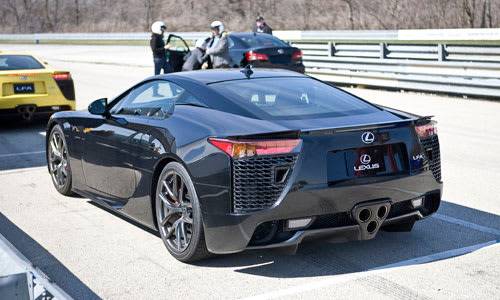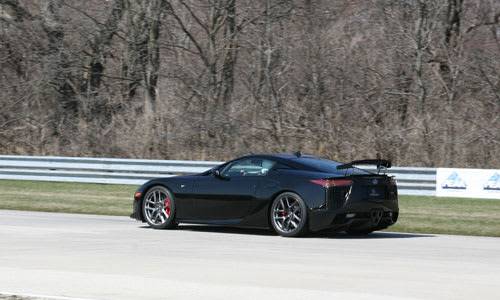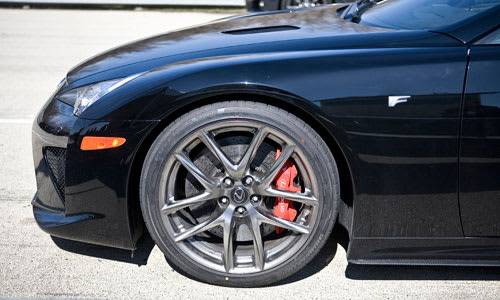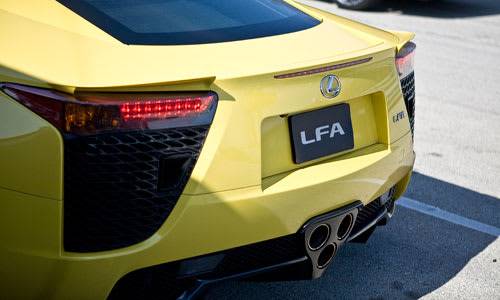2012 Lexus LFA: First Drive


One black and one yellow LFA looked right at home on the track — with all the presence of a Ferrari, Lamborghini or Audi R8 — though distinctly Japanese in terms of styling. Some folks have likened it to the Nissan GT-R, but the LFA looks considerably different in person, with rear-mounted vents that suggest a mid-engine car, even though its engine is actually in the front. The transmission and radiators are in the rear, so that’s where most of the cooling takes place. I preferred the yellow model, but anyone who finds the front and rear vents — or any other design cue — too prominent might prefer a darker color.
As the LFA flew by the pits, its sound was that of a Formula One car, more high-pitched howl than rumble or growl. The similarity doesn’t end there.
&&&&&EMBEDDED_ELEMENT_START&&&&& {“id”:1420668679680,”originalName”:”2015_03_04_17_03_18_037_http___blogs_cars_com__a_6a00d83451b3c669e2014e6060ee05970c_800wi”,”name”:”MMS ID 50425 (created by CM Utility)”,”URI”:”/73/-701775593-1425510198273.”,”createDate”:”2015-03-04 05:03:18″,”metadata”:{“AUTHOR”:”automatic-content-migration”,”KEYWORDS”:””},”href”:”https://www.cstatic-images.com/stock/1170×1170/73/-701775593-1425510198273.”,”description”:”Came from http://blogs.cars.com/.a/6a00d83451b3c669e2014e6060ee05970c-800wi”,”externalid”:”50425″,”updatedby”:”cmuadmin”,”updateddate”:1425511504262,”associations”:{}} &&&&&EMBEDDED_ELEMENT_END&&&&&
When the six-speed paddle-shifted transmission is in Neutral, the normally aspirated 4.8-liter V-10 engine builds and dumps rpm at an astounding rate. Lexus says the engine goes from idle to the 9,000 rpm redline in 0.6 second. I noted the same characteristic in my review of the R8 V-10, but it seems even more pronounced here. In this era of electronic throttle control and efficiency-driven drivetrain management, it stands out all the more.
With 552 horsepower at 8,700 rpm and 354 pounds-feet of torque at 6,800 rpm, the LFA launches with authority. You want to keep the engine revving for maximum pull, but the torque feels stronger than the modest rating and peak rpm suggest. Lexus composed 65 percent of the car’s underlying structure, by weight, out of carbon-fiber-reinforced plastic, which keeps the car reasonably light. The hood and liftgate are also composites, minimizing weight fore and aft of the wheels. The body panels and doors, however, are aluminum, which Lexus says will keep fender bender repair costs within reason.

The LFA’s handling is its best attribute. With a front/rear weight distribution of 48/52, it feels reasonably balanced and manageable. The steering precision and feedback are excellent, and that’s not exactly a Lexus hallmark. Lexus representatives warned about abrupt inputs, but the steering always brought me smoothly where I wanted to go. Not so the sensitive accelerator. It was an effort every time I switched from braking to the go-pedal not to break the tail loose and trigger the stability system. I adapted as much as I could, but the electronic throttle mapping needs to be toned down. It’s more sensitive when the car is in Sport mode, but I’d prefer if it stayed the way it is in Normal.

Unlike most of the automated-manual transmissions now on the market, including those from Audi and Ferrari, the LFA employs a single-clutch design, ostensibly chosen for its relatively low weight versus the dual-clutch type. I’ve always criticized the single-clutch approach regardless of the source, including performance icons like BMW and Lamborghini, for its balkiness in normal driving. Though a single clutch is right at home on the track, a dual-clutch is equally adept at both casual and performance driving.

I have mixed feelings about the LFA’s twitchiness and track-oriented transmission. I frequently bemoan how genteel performance cars have become, and long for the visceral aspect that seems to be disappearing. Thanks to automatic transmissions and all variety of electronic nannies, practically anyone can handle the most capable performance vehicles in the world. Learning a car’s characteristics, forming a relationship with it and bridling the wild beast used to be part of the deal. To find even this small amount of rawness from Lexus, of all sources, is a little surprising. In some ways I like it, but I definitely would have gotten off the fence and gone with either a proper manual or a dual-clutch automatic.
The LFA is a bid for performance credibility from a company that originally had none and didn’t care, and has attempted only sporadically to dial it up. In my opinion, Audi built up to its R8 supercar after a string of successful performance-oriented models. If Lexus is to get more out of its LFA than a high purchase price, the brand is going to have to start building down.


Former Executive Editor Joe Wiesenfelder, a Cars.com launch veteran, led the car evaluation effort. He owns a 1984 Mercedes 300D and a 2002 Mazda Miata SE.
Featured stories




